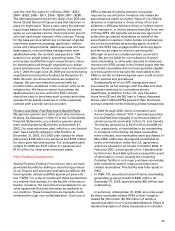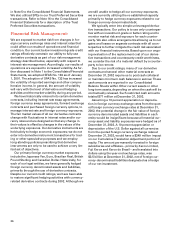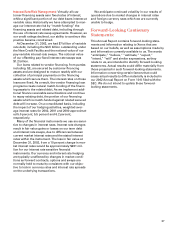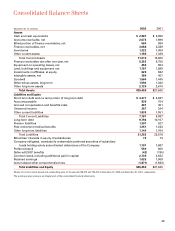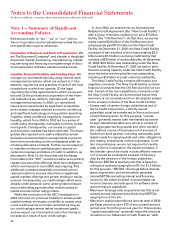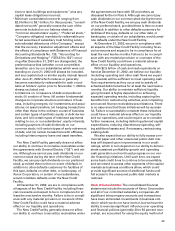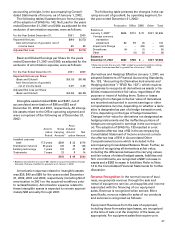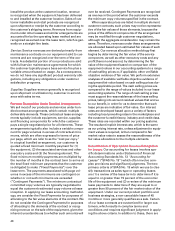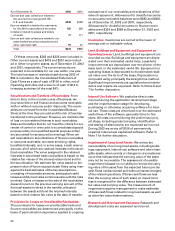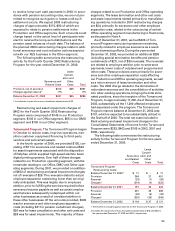Xerox 2002 Annual Report Download - page 46
Download and view the complete annual report
Please find page 46 of the 2002 Xerox annual report below. You can navigate through the pages in the report by either clicking on the pages listed below, or by using the keyword search tool below to find specific information within the annual report.
44
The following table summarizes the more significant
charges that require management estimates:
Year ended December 31,
(in millions) 2002 2001 2000
Restructuring provisions and
asset impairments $670 $ 715 $ 475
Amortization and impairment
of goodwill and intangible assets 99 94 86
Provisions for receivables 353 506 613
Provisions for obsolete and
excess inventory 115 242 235
Depreciation and obsolecence
of equipment on
operating leases 408 657 626
Depreciation of buildings
and equipment 341 402 417
Amortization of capitalized software 249 179 115
Pension benefits – net periodic
benefit cost 168 99 44
Other post-retirement benefits –
net periodic benefit cost 120 130 109
Deferred tax asset valuation
allowance provisions 15 247 12
Changes in Estimates: In the ordinary course of
accounting for items discussed above, we make
changes in estimates as appropriate, and as we
become aware of circumstances surrounding those
estimates. Such changes and refinements in estima-
tion methodologies are reflected in reported results
of operations in the period in which the changes are
made and, if material, their effects are disclosed in the
Notes to the Consolidated Financial Statements.
New Accounting Standards and Accounting Changes:
Variable Interest Entities: In January 2003, the FASB
issued Interpretation No. 46, “Consolidation of
Variable Interest Entities, an interpretation of ARB 51”
(“FIN 46”). The primary objectives of FIN 46 are to
provide guidance on the identification of entities for
which control is achieved through means other than
through voting rights (“VIEs”) and how to determine
when and which business enterprise should consoli-
date the VIE. This new model for consolidation
applies to an entity which either (1) the equity
investors (if any) do not have a controlling financial
interest or (2) the equity investment at risk is
insufficient to finance that entity’s activities without
receiving additional subordinated financial support
from other parties. We do not expect the adoption of
this standard to have any impact on our results of
operations, financial position or liquidity.
Guarantees: In November 2002, the FASB issued
Interpretation No. 45, “Guarantor’s Accounting and
Disclosure Requirements for Guarantees, Including
Indirect Guarantees of Indebtedness of Others” (“FIN
accounting. Upon the sale of stock of a subsidiary,
we recognize a gain or loss in our Consolidated
Statements of Income equal to our proportionate
share of the corresponding increase or decrease in
that subsidiary’s equity. Operating results of acquired
businesses are included in the Consolidated
Statements of Income from the date of acquisition.
For further discussion of acquisitions, refer to Note 3.
Certain reclassifications of prior year amounts
have been made to conform to the current year
presentation.
Income (Loss) before Income Taxes (Benefits), Equity
Income, Minorities’ Interests and Cumulative Effect of
Change in Accounting Principle: Throughout the
Notes to the Consolidated Financial Statements, we
refer to the effects of certain changes in estimates and
other adjustments on Income (Loss) before Income
Taxes (Benefits), Equity Income, Minorities’ Interests
and Cumulative Effect of Change in Accounting
Principle. For convenience and ease of reference, that
caption in our Consolidated Statements of Income is
hereafter referred to as “pre-tax income (loss).”
Use of Estimates: The preparation of our consolidated
financial statements in accordance with accounting
principles generally accepted in the United States of
America requires that we make estimates and
assumptions that affect the reported amounts of
assets and liabilities, as well as the disclosure of con-
tingent assets and liabilities at the date of the financial
statements, and the reported amounts of revenues
and expenses during the reporting period. Significant
estimates and assumptions are used for, but not limit-
ed to: (i) allocation of revenues and fair values in mul-
tiple element arrangements; (ii) accounting for
residual values; (iii) economic lives of leased assets;
(iv) allowance for doubtful accounts; (v) retained inter-
ests associated with the sales of accounts or finance
receivables; (vi) inventory valuation; (vii) restructuring
and other related charges; (viii) asset impairments;
(ix) depreciable lives of assets; (x) useful lives of
intangible assets and goodwill (in 2002 goodwill is no
longer amortized over an estimated useful life, see
below for further discussion); (xi) pension and post-
retirement benefit plans; (xii) income tax valuation
allowances and (xiii) contingency and litigation
reserves. Future events and their effects cannot be
predicted with certainty; accordingly, our accounting
estimates require the exercise of judgment. The
accounting estimates used in the preparation of our
consolidated financial statements will change as new
events occur, as more experience is acquired, as addi-
tional information is obtained and as our operating
environment changes. Actual results could differ from
those estimates.



